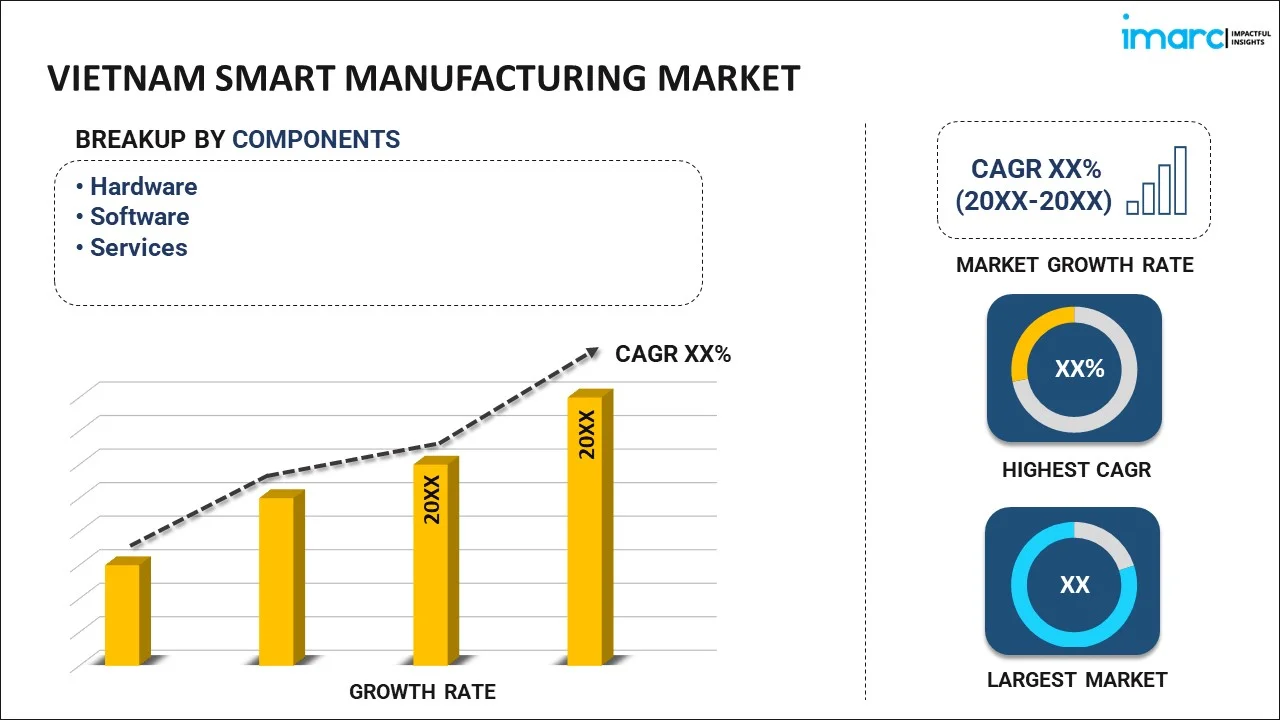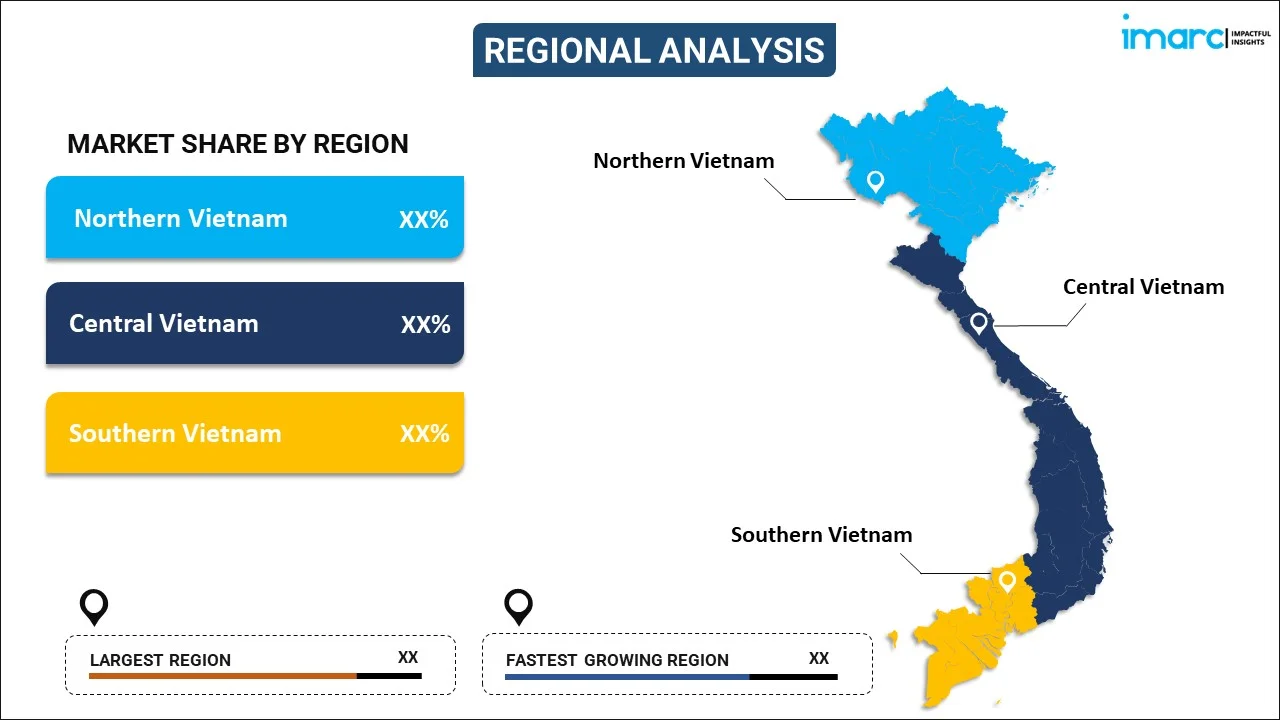IMARC made the whole process easy. Everyone I spoke with via email was polite, easy to deal with, kept their promises regarding delivery timelines and were solutions focused. From my first contact, I was grateful for the professionalism shown by the whole IMARC team. I recommend IMARC to all that need timely, affordable information and advice. My experience with IMARC was excellent and I can not fault it.
Read More
Vietnam Smart Manufacturing Market Report by Component (Hardware, Software, Services), Technology (Machine Execution Systems, Programmable Logic Controller, Enterprise Resource Planning, SCADA, Discrete Control Systems, Human Machine Interface, Machine Vision, 3D Printing, Product Lifecycle Management, Plant Asset Management), End Use (Automotive, Aerospace and Defense, Chemicals and Materials, Healthcare, Industrial Equipment, Electronics, Food and Agriculture, Oil and Gas, and Others), and Region 2024-2032
Market Overview:
The Vietnam smart manufacturing market size is projected to exhibit a growth rate (CAGR) of 11.20% during 2024-2032. The increasing labor costs across the region, several technological advancements in automation, artificial intelligence (AI), and the Internet of Things (IoT), and the implementation of several initiatives such as incentives, tax breaks, and subsidies to create a favorable environment represent some of the key factors driving the market.
|
Report Attribute
|
Key Statistics
|
|---|---|
|
Base Year
|
2023 |
|
Forecast Years
|
2024-2032
|
|
Historical Years
|
2018-2023
|
| Market Growth Rate (2024-2032) | 11.20% |
Smart manufacturing, also known as Industry 4.0 or the Industrial Internet of Things (IIoT), represents a transformative approach to manufacturing processes that uses advanced technology to optimize operations, enhance efficiency, and drive innovation. It integrates various digital technologies and data-driven solutions to streamline manufacturing processes, reduce costs, and improve product quality, which is gaining importance in companies across industries seeking to stay competitive in an increasingly digital and interconnected world. It relies on the seamless connectivity of machines, devices, and systems within a manufacturing environment. Some of the components of smart manufacturing include the Internet of Things (IoT) sensors, big data analytics, automation, robotics, cloud computing, cybersecurity, artificial intelligence (AI), and machine learning (ML). For instance, IoT sensors are embedded in machines and equipment to collect real-time data on their performance, which monitor factors including temperature, humidity, pressure, and machine usage, providing valuable insights into the manufacturing process. Additionally, big data analytics collects data and processes and analyses it using advanced analytics tools, which allow manufacturers to identify patterns, anomalies, and areas for improvement, facilitating data-driven decision-making. Consequently, smart manufacturing often involves the use of robots and automated systems to handle repetitive tasks, increasing production efficiency and reducing the risk of errors.
Vietnam Smart Manufacturing Market Trends:
The market is primarily driven by the increasing labor costs, encouraging manufacturers to seek ways to offset these rising expenses by adopting smart manufacturing solutions that enhance productivity and reduce reliance on manual labor. In addition, the implementation of several initiatives such as incentives, tax breaks, and subsidies for companies investing in these technologies to support them is creating a favorable environment for the growth of the smart manufacturing sector, thus influencing market growth. It is also encouraging the adoption of smart manufacturing technologies. Moreover, several advancements in automation, artificial intelligence (AI), and the Internet of Things (IoT) have made smart manufacturing more accessible and cost-effective, representing another major growth-inducing factor. Along with this, manufacturers in Vietnam are using these technologies to improve production efficiency, quality control, and supply chain management, further propelling market growth. Apart from this, smart manufacturing technologies allow companies to maintain consistent product quality and reduce defects, which is particularly important in industries including electronics and textiles, where quality is paramount. As a result, businesses are investing in smart manufacturing to meet international quality standards and gain a competitive edge in global markets. Furthermore, the onset of the COVID-19 pandemic highlighted the risks associated with over-reliance on a single source of manufacturing, resulting in companies looking to diversify their supply chains and reduce dependence on a single location, making Vietnam an attractive destination for smart manufacturing due to its strategic location and growing infrastructure, thus creating a positive market outlook.
Vietnam Smart Manufacturing Market Segmentation:
IMARC Group provides an analysis of the key trends in each segment of the market, along with forecasts at the country level for 2024-2032. Our report has categorized the market based on component, technology, and end use.
Component Insights:

- Hardware
- Software
- Services
The report has provided a detailed breakup and analysis of the market based on the component. This includes hardware, software, and services.
Technology Insights:
- Machine Execution Systems
- Programmable Logic Controller
- Enterprise Resource Planning
- SCADA
- Discrete Control Systems
- Human Machine Interface
- Machine Vision
- 3D Printing
- Product Lifecycle Management
- Plant Asset Management
A detailed breakup and analysis of the market based on the technology have also been provided in the report. This includes machine execution systems, programmable logic controller, enterprise resource planning, SCADA, discrete control systems, human machine interface, machine vision, 3D printing, product lifecycle management, and plant asset management.
End Use Insights:
- Automotive
- Aerospace and Defense
- Chemicals and Materials
- Healthcare
- Industrial Equipment
- Electronics
- Food and Agriculture
- Oil and Gas
- Others
The report has provided a detailed breakup and analysis of the market based on the end use. This includes automotive, aerospace and defense, chemicals and materials, healthcare, industrial equipment, electronics, food and agriculture, oil and gas, and others.
Regional Insights:

- Northern Vietnam
- Central Vietnam
- Southern Vietnam
The report has also provided a comprehensive analysis of all the major regional markets, which include Northern Vietnam, Central Vietnam, and Southern Vietnam.
Competitive Landscape:
The market research report has also provided a comprehensive analysis of the competitive landscape in the market. Competitive analysis such as market structure, key player positioning, top winning strategies, competitive dashboard, and company evaluation quadrant has been covered in the report. Also, detailed profiles of all major companies have been provided.
Vietnam Smart Manufacturing Market Report Coverage:
| Report Features | Details |
|---|---|
| Base Year of the Analysis | 2023 |
| Historical Period | 2018-2023 |
| Forecast Period | 2024-2032 |
| Units | US$ Billion |
| Scope of the Report | Exploration of Historical and Forecast Trends, Industry Catalysts and Challenges, Segment-Wise Historical and Predictive Market Assessment:
|
| Components Covered | Hardware, Software, Services |
| Technologies Covered | Machine Execution Systems, Programmable Logic Controller, Enterprise Resource Planning, SCADA, Discrete Control Systems, Human Machine Interface, Machine Vision, 3D Printing, Product Lifecycle Management, Plant Asset Management |
| End Uses Covered | Automotive, Aerospace and Defense, Chemicals and Materials, Healthcare, Industrial Equipment, Electronics, Food and Agriculture, Oil and Gas, Others |
| Regions Covered | Northern Vietnam, Central Vietnam, Southern Vietnam |
| Customization Scope | 10% Free Customization |
| Report Price and Purchase Option | Single User License: US$ 3699 Five User License: US$ 4699 Corporate License: US$ 5699 |
| Post-Sale Analyst Support | 10-12 Weeks |
| Delivery Format | PDF and Excel through Email (We can also provide the editable version of the report in PPT/Word format on special request) |
Key Questions Answered in This Report:
- How has the Vietnam smart manufacturing market performed so far and how will it perform in the coming years?
- What has been the impact of COVID-19 on the Vietnam smart manufacturing market?
- What is the breakup of the Vietnam smart manufacturing market on the basis of component?
- What is the breakup of the Vietnam smart manufacturing market on the basis of technology?
- What is the breakup of the Vietnam smart manufacturing market on the basis of end use?
- What are the various stages in the value chain of the Vietnam smart manufacturing market?
- What are the key driving factors and challenges in the Vietnam smart manufacturing?
- What is the structure of the Vietnam smart manufacturing market and who are the key players?
- What is the degree of competition in the Vietnam smart manufacturing market?
Key Benefits for Stakeholders:
- IMARC’s industry report offers a comprehensive quantitative analysis of various market segments, historical and current market trends, market forecasts, and dynamics of the Vietnam smart manufacturing market from 2018-2032.
- The research report provides the latest information on the market drivers, challenges, and opportunities in the Vietnam smart manufacturing market.
- Porter's five forces analysis assist stakeholders in assessing the impact of new entrants, competitive rivalry, supplier power, buyer power, and the threat of substitution. It helps stakeholders to analyze the level of competition within the Vietnam smart manufacturing industry and its attractiveness.
- Competitive landscape allows stakeholders to understand their competitive environment and provides an insight into the current positions of key players in the market.
Need more help?
- Speak to our experienced analysts for insights on the current market scenarios.
- Include additional segments and countries to customize the report as per your requirement.
- Gain an unparalleled competitive advantage in your domain by understanding how to utilize the report and positively impacting your operations and revenue.
- For further assistance, please connect with our analysts.

Purchase Options
Benefits of Customization
Personalize this research
Triangulate with your data
Get data as per your format and definition
Gain a deeper dive into a specific application, geography, customer, or competitor
Any level of personalization
Get in Touch With Us
UNITED STATES
Phone: +1-631-791-1145
INDIA
Phone: +91-120-433-0800
UNITED KINGDOM
Phone: +44-753-714-6104
Email: sales@imarcgroup.com
 Inquire Before Buying
Inquire Before Buying Speak to an Analyst
Speak to an Analyst  Request Brochure
Request Brochure  Request Customization
Request Customization



.webp)




.webp)












